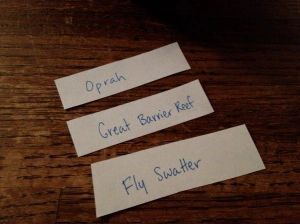Intended for groups of 4 or more, Fishbowl is a guessing game that can be played in all types of settings as it only requires pen and paper (and preferably some type of bowl). Essentially an expanded version of Charades, Fishbowl cannot be pinpointed to one original creator. To play, players are split into two teams and write down words/phrases on cards that will be guessed later on. Players from each team alternate turns, giving clues for their team to guess as many cards as possible within an allotted amount of time. A game of Fishbowl progresses through three rounds: 1) taboo, where players solely use words to describe the word/phrase on the card; 2) charades, where players solely use gestures; and 3) password, where players can only say one word. Like Charades, Fishbowl gets more fun with more players, so the intended audience is people at gatherings/parties.


Our team’s game, which I will refer to as “Improvise,” is a guessing game where players are split into two teams and must select a Scenario Card, a Character Card, and a Limitation card. Essentially, two or more players must act out a specific scenario (ex. You break up with your partner), each acting as a certain character (ex. A pizza delivery guy, a tourist, Justin Bieber, etc.) under one randomly-drawn limitation (ex. You must say the word “tomato”). Teammates are shown the Scenario Card, but must guess the character that the actors are impersonating.
Central Argument
Both Fishbowl and Improvise are performative, round-based guessing games that give rise to the aesthetics of fellowship, competition, expression, and challenge. However, the two games differ mechanistically in how they enforce limitations upon the actor, and dynamically in terms of how – unlike Fishbowl’s solo-performing nature – Improvise requires multiple actors to collaborate to effectively communicate clues to their team. I argue that Improvise, through its more elaborate mechanics, expands upon Fishbowl’s sense of challenge, expression, and fellowship.
Similarities
Fellowship and competition are two core aesthetics that emerge hand-in-hand from both Fishbowl and Improvise. Driven by an innate desire to be on top, the two teams in these zero-sum games compete against each other to be the ultimate winner. As both games are round-based, players feel an urgent need to maximize the utility of each round to come out victorious. Driven by competition, teammates must collaborate and communicate effectively, all while naturally forming bonds through the light-hearted nature of the game and the silliness that it invites.
Expression and challenge are another two core aesthetics that go hand-in-hand in both games. As players receive some type of prompt and are required to be in the spotlight and communicate clues to their team, expression is ingrained in the core of both games. However, both games enforce limitations on the actors’ expression which makes guessing not so easy. Constrained by these limitations, teams must piece together clues to make an informed guess, and from there, the aesthetic of challenge emerges.
Differences
However, although both games enforce limitations on the actors’ expression, Improvise enforces more limitations, more specific limitations, and more unpredictable limitations. Whereas Fishbowl’s limitations were structurally defined by the three rounds (taboo, charades, password), Improvise’s limitations are three-part: actors will be assigned a certain role (ex. X breaks up with Y. Player with the soonest birthday is X); actors each need to impersonate a character based on the Character Card they draw (ex. A vampire, Joe Biden); and actors need to draw a Limitation Card (ex. Must use the word “supercalifragilisticexpialidocious”). In this sense, the mechanics of Improvise are more elaborate compared to Fishbowl and therefore give rise to greater challenge and room for expression through improvisation.

In addition, whereas in Fishbowl each player takes turns being the solo actor, in Improvise, multiple teammates must perform together in order to act out a given scenario. As a result, I argue that Improvise fosters more fellowship than Fishbowl might, as the interplay between actors gives rise to new avenues for bonding, entertainment, and play. Additionally, teammates enjoy the dynamic and whimsical nature of improvised scenarios, unlike the more straightforward clues in Fishbowl. Because of this, Improvise fosters more dynamic, high-energy gameplay than Fishbowl, contributing to more engagement and, as a result, more fellowship.

Conclusion
Fishbowl and Improvise are two games that overlap in overarching themes such as performance, guessing, and competition. However, Improvise takes the aesthetics of Fishbowl to another level, as seen through how Improvise’s elaborate limitation mechanics hone in on challenge, how its improvisational nature gives more room for expression, and how its scenarios necessitate the co-performance of teammates and thereby increases fellowship. Overall, when comparing Fishbowl and Improvise, we see that the more intricate mechanics of Improvise contribute to a heightened intensity in the aesthetic experience cultivated by the game.




